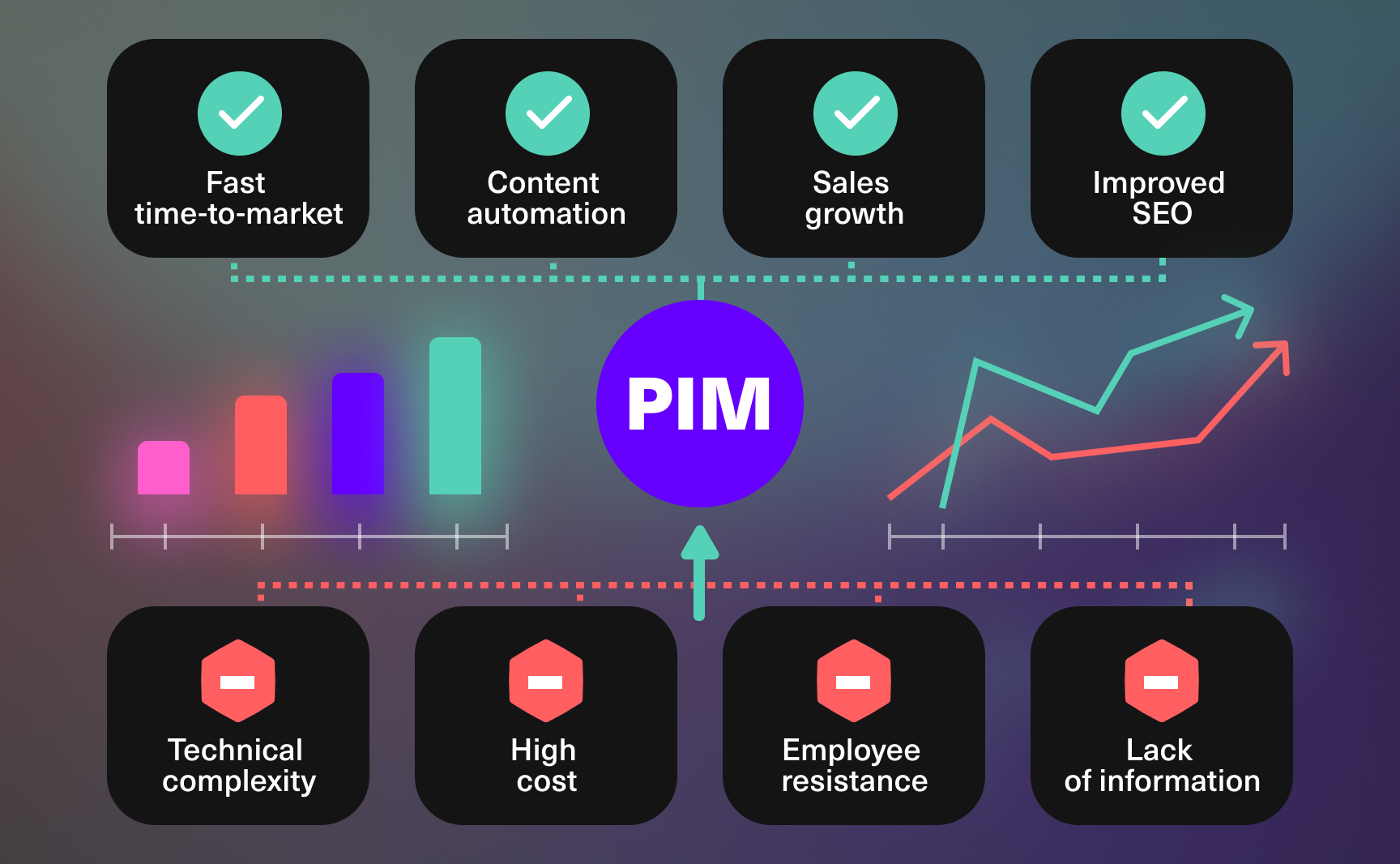Good content management is key to growing in e-commerce. But many companies delay using PIM systems because they worry it’s too complex or risky. As a result, they miss out on important competitive advantages.
At first, setting up a PIM system can seem hard and time-consuming. It involves connecting with current systems, changing workflows, and training staff. Many companies see this as extra work and put it off until it’s absolutely needed.
But what happens if you delay using a PIM system?

Problems from Not Using a PIM System
Companies that don’t use a PIM system often face serious problems:
Content Errors. Manual data handling leads to many mistakes — like wrong names, prices, specs, or images. This causes returns, complaints, and damages trust in the brand. It also makes customer service harder and leads to unhappy customers.
Delays in Product Launches. Slow content creation and publishing delay new product launches and hurt competitiveness. These delays often come from long approval steps and trouble adjusting content for different sales channels. As a result, faster-moving competitors get ahead.
Data Inconsistency. Not having a single source of data or clear content processes leads to mistakes — like wrong prices, specs, or product info. This causes confusion for both employees and customers, makes analytics harder, and hurts the quality of customer service.
SEO Performance Decline. Badly managed content and poor keyword use lower product rankings in search results. Without clear and unique descriptions, products get less visibility and traffic, which means fewer sales. As a result, companies have to spend more on ads and marketing.
Typical Content Errors
Companies that manage content manually often run into errors like:
Duplicate Information. The same product has different descriptions, specs, or images, which causes confusion.
Irrelevant Content. Generic text that doesn’t match the product, hurting user experience and sales.
Wrong Specs. Incorrect product details that lead to returns and bad reviews.
Typos and Mistakes. Errors that reduce customer trust and damage brand reputation.
Too Many Keywords. Makes content hard to read and hurts SEO.
Incomplete Descriptions. Missing key info that makes it harder for customers to decide.
Wrong Images. Pictures that don’t match the product confuse buyers and reduce sales.
As a result, companies lose money, see lower sales, and risk harming their reputation.
Why Companies Are Afraid to Start Using PIM
Even with clear benefits, companies often put off using PIM because of a few common reasons:
Complex Integration. Companies worry that connecting PIM with their ERP, CRM, and other systems will take too much time, money, and effort. Many use old, disconnected tools, and linking them all feels risky. It could slow down work or even cause data issues.
High Costs. Companies worry that setting up and running a PIM system may cost more than it’s worth. This includes licenses, setup, training, hiring, support, and updates. Without a clear view of ROI, the upfront cost can feel too big.
Employee Resistance. People often don’t like changing familiar routines. They may worry about learning new tools, more work, or losing comfort with what they already know. This can make them less open to using new systems like PIM.
Lack of Awareness. Many companies don’t know what PIM systems can do or how they help. Without clear examples or results, leaders see PIM as something they don’t really need and keep delaying the decision.
How to Get Past the Barriers and Start Using PIM Successfully
1. Gradual Integration
Taking it step by step reduces risks, makes the transition easier, and helps employees adapt. Here’s how:
- Start with a small pilot project
- Integrate systems one at a time
- Provide short, regular training sessions
- Improve the process based on feedback
2. ROI Calculation and Clear Benefits
Clearly calculating ROI shows why PIM is a smart investment:
- It saves time and reduces errors
- It speeds up product launches
- It boosts content quality and sales
- It lowers the need for manual work and support
3. Easy Employee Training and Adaptation
Employee engagement is key:
- Involve them early in the process
- Explain how PIM will make their work easier
- Provide hands-on training and support
- Listen to feedback and adjust as needed
4. Communication and Transparency
Essential for successful adoption:
- Clear communication about goals and benefits
- Step-by-step onboarding and support
- Ongoing training and easy-to-follow guides
- Encouraging feedback and involving team members in the process
Using a PIM system may seem like a big change, but it brings clear benefits: fewer errors, faster product launches, better content, and smoother workflows. By taking a step-by-step approach, showing ROI, and supporting your team, you can overcome challenges and make the switch successful. In the end, it helps your business grow, stay competitive, and deliver a better customer experience.
With PIM MARKETPROVIDER, you get all these advantages in one easy-to-use platform. You can start exploring it right now — full functionality is available after a quick registration
Don’t wait — take the first step toward faster, smarter product content management today.